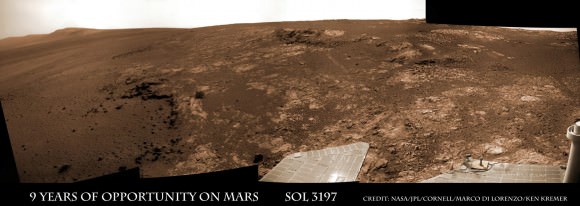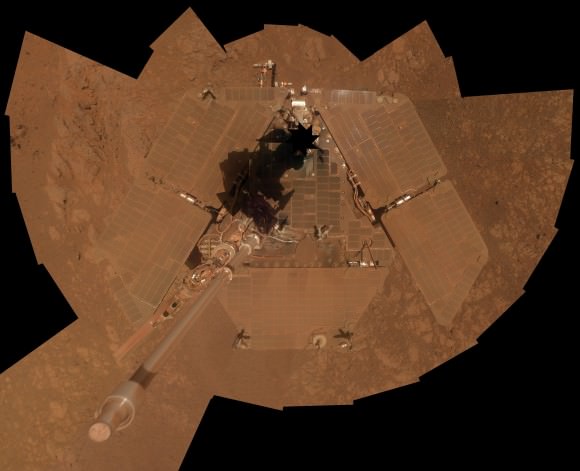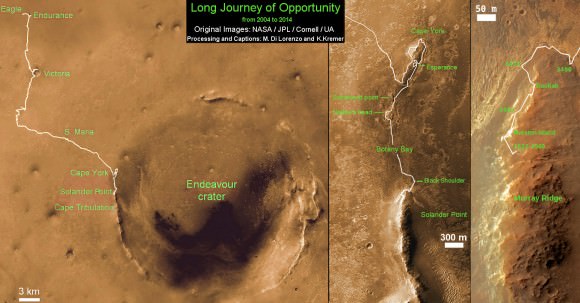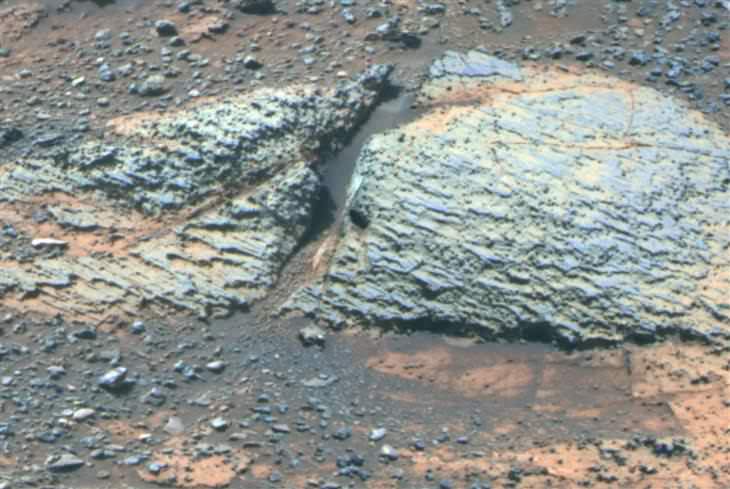After a decade of roving relentlessly on the Red Planet, NASA’s Opportunity rover discovered rocks that preserve the best evidence yet that ancient Mars was the most conducive time period for the formation of life on our Solar System’s most Earth-like Planet, according to the science leaders of the mission.
Opportunity found the rocks – laden with clay minerals – barely over half a year ago in the spring of 2013, at an outcrop named ‘Whitewater Lake’ along an eroded segment of a vast crater named Endeavour that spans some 22 kilometers (14 miles) in diameter.
“These rocks are older than any we examined earlier in the mission, and they reveal more favorable conditions for microbial life than any evidence previously examined by investigations with Opportunity,” says Opportunity Deputy Principal Investigator Ray Arvidson, a professor at Washington University in St. Louis.
Opportunity investigated the rocks at a spot dubbed Matejivic Hill where researchers believe iron-rich smectite was produced in an aqueous environment some 4 billion years ago that was relatively benign and with a nearly neutral pH – thus offering potential life forms a habitable zone with a far better chance to originate and thrive for perhaps as long as hundreds of millions of years.
The new scientific findings are being published in the journal Science on Jan. 24, which just happens to exactly coincide with Opportunity’s landing on the Red Planet ten years ago at Meridiani Planum.
Matejivic Hill is located on the Cape York rim segment of Endeavour crater. See locations on our Opportunity route map below.
“The punch line here is that the oldest rocks Opportunity has examined were formed under very mild conditions — conditions that would have been a much better niche for life, and also much better for the preservation of organic materials that would have been produced,” said Arvidson at a NASA media briefing today, Jan. 23.

Immediately after landing on Mars on Jan.24, 2004 inside Eagle crater, the six wheeled robot found rocks within her eyesight that provided concrete evidence that eons ago Mars was much warmer and wetter compared to the cold, arid conditions that exist today.
Although those sulfate rich rocks proved that liquid water once flowed on the surface of the Red Planet, they also stem from a time period with a rather harsh environment that was extremely acidic, containing significant levels of sulfuric acid that would not be friendly to the formation or sustainability of potential Martian life forms.
“Evidence is thus preserved for water-rock interactions of the aqueous environments of slightly acidic to circum-neutral pH that would have been more favorable for prebiotic chemistry and microorganisms than those recorded by younger sulfate-rich rocks at Meridiani Planum,” Ardivson wrote in the Science paper, of which he is the lead author, along with many other team members.

The science team directed Opportunity to Matejivic Hill and the ‘Whitewater Lake’ area of outcrops based on predictions from spectral observations collected from the CRISM spectrometer aboard one of NASA’s spacecraft circling overhead the Red Planet – the powerful Mars Reconnaissance Orbiter (MRO).
Opportunity arrived at Mars barely 3 weeks after her twin sister, Spirit on 3 January 2004.
The long lived robot has been methodically exploring along the rim of Endeavour crater since arriving in August 2011.
The newly published results from Opportunity correlate very well with those from sister rover Curiosity which likewise found a habitable zone where drinkable water once flowed on the opposite side of Mars.
The combined discoveries from the golf cart sized Opportunity and the SUV sized Curiosity tell us that the presence of liquid water was widespread on ancient Mars.
“The more we explore Mars, the more interesting it becomes. These latest findings present yet another kind of gift that just happens to coincide with Opportunity’s 10th anniversary on Mars,” said Michael Meyer, lead scientist for NASA’s Mars Exploration Program.
“We’re finding more places where Mars reveals a warmer and wetter planet in its history. This gives us greater incentive to continue seeking evidence of past life on Mars.”
Opportunity is currently investigating a new cache of clay mineral outcrops by the summit of Solander Point, a rim segment just south of Cape York and Matejivic Hill.
These outcrops were likewise detected by the CRISM spectrometer aboard MRO. The hunt for these outcrops was detailed in earlier discussions I had with Ray Arvidson.

Today marks Opportunity’s 3555th Sol or Martian Day roving Mars – for what was expected to be only a 90 Sol mission.
So far she has snapped over 188,200 amazing images on the first overland expedition across the Red Planet.
Her total odometry stands at over 24.07 miles (38.73 kilometers) since touchdown on Jan. 24, 2004 at Meridiani Planum.
Read more about sister Spirit – here and here.
Meanwhile on the opposite side of Mars, Opportunity’s younger sister rover Curiosity is trekking towards gigantic Mount Sharp. She celebrated 500 Sols on Mars on New Years Day 2014.
And a pair of new orbiters are streaking to the Red Planet to fortify the Terran fleet- NASA’s MAVEN and India’s MOM.
Finally, China’s Yutu rover is trundling across pitted moonscapes.
Stay tuned here for Ken’s continuing Opportunity, Curiosity, Chang’e-3, LADEE, MAVEN, Mars rover and MOM news.


This map shows the entire path the rover has driven during a decade on Mars and over 3540 Sols, or Martian days, since landing inside Eagle Crater on Jan 24, 2004 to current location by f Solander Point summit at the western rim of Endeavour Crater. Rover will spnd 6th winter here atop Solander. Opportunity discovered clay minerals at Esperance – indicative of a habitable zone. Credit: NASA/JPL/Cornell/ASU/Marco Di Lorenzo/Ken Kremer


Awesome article! Thanks, Ken.
Judging from the Opportunity’s self-portrait, future solar powered Mars rovers should be equipped with sort of a wet cloth or a soft broom to wipe their solar panels. 😉
I still don’t understand why they didn’t think about that.
Perhaps they thought the rovers might fail before the dust on the solar panels could become a problem.
air compressor and puff puff.
awesome rover! thanks!